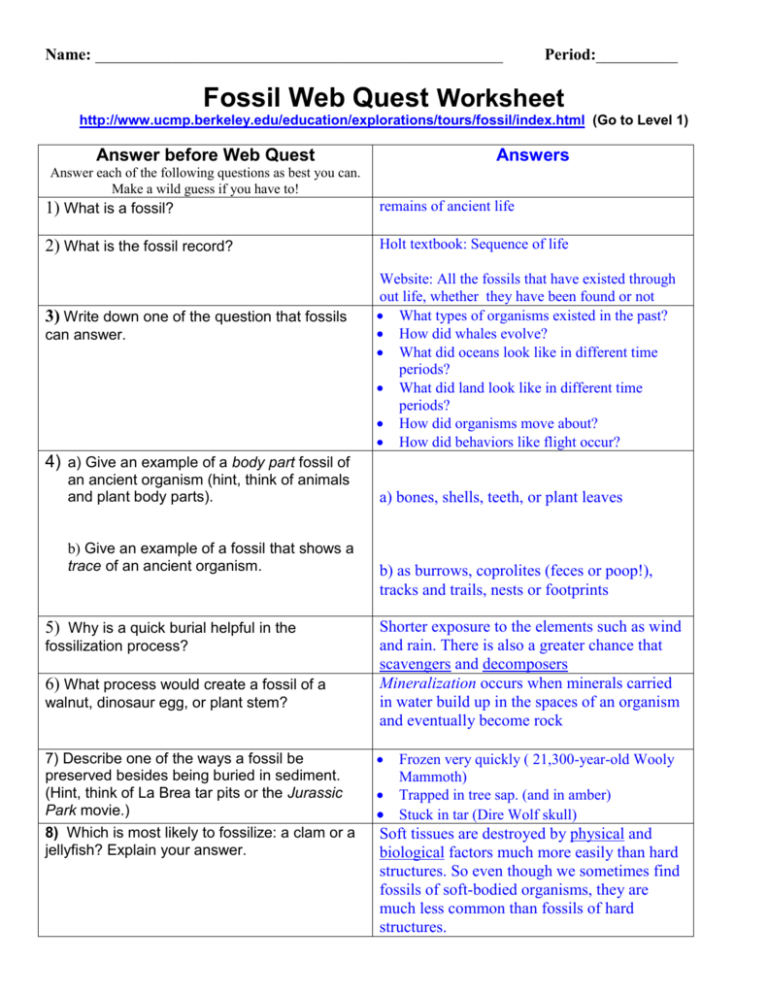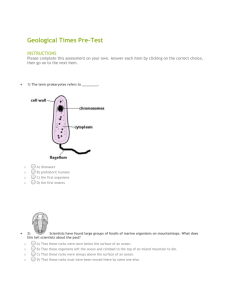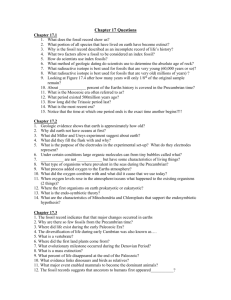Fossil Web Quest Worksheet
advertisement

Name: __________________________________________________ Period:__________ Fossil Web Quest Worksheet http://www.ucmp.berkeley.edu/education/explorations/tours/fossil/index.html (Go to Level 1) Answer before Web Quest Answers Answer each of the following questions as best you can. Make a wild guess if you have to! 1) What is a fossil? remains of ancient life 2) What is the fossil record? Holt textbook: Sequence of life 3) Write down one of the question that fossils can answer. Website: All the fossils that have existed through out life, whether they have been found or not What types of organisms existed in the past? How did whales evolve? What did oceans look like in different time periods? What did land look like in different time periods? How did organisms move about? How did behaviors like flight occur? 4) a) Give an example of a body part fossil of an ancient organism (hint, think of animals and plant body parts). b) Give an example of a fossil that shows a trace of an ancient organism. 5) Why is a quick burial helpful in the fossilization process? 6) What process would create a fossil of a walnut, dinosaur egg, or plant stem? 7) Describe one of the ways a fossil be preserved besides being buried in sediment. (Hint, think of La Brea tar pits or the Jurassic Park movie.) 8) Which is most likely to fossilize: a clam or a jellyfish? Explain your answer. a) bones, shells, teeth, or plant leaves b) as burrows, coprolites (feces or poop!), tracks and trails, nests or footprints Shorter exposure to the elements such as wind and rain. There is also a greater chance that scavengers and decomposers Mineralization occurs when minerals carried in water build up in the spaces of an organism and eventually become rock Frozen very quickly ( 21,300-year-old Wooly Mammoth) Trapped in tree sap. (and in amber) Stuck in tar (Dire Wolf skull) Soft tissues are destroyed by physical and biological factors much more easily than hard structures. So even though we sometimes find fossils of soft-bodied organisms, they are much less common than fossils of hard structures. 9) Rate how good or bad these environments are for creating fossils. (1 is great and 4 is terrible.) ___ Lakes ___ Ocean floor (“Benthic ocean”) _2__ Lakes ___Rain forests ___ Rocky ocean shore (“Intertidal zone”) _4__Rain forests 10) O Of the organisms alive now, what Less than 10%! __1_ Ocean floor _4__ Ocean shore percentage will eventually become fossils? Circle the best answer below. a. Less than 10% c. 25% -50% b.10% -25% d. More than 50% 11) What are two processes that might destroy a fossil after it has been formed? (Hint: Remember your 6th Grade Earth Science.) Melted Moved Crushed Eroded a) b) 12) Circle the t type of rock you would most likely find fossils. (Hint: Read page 224 in textbook to review types of rocks.) a. igneous c. sedimentary b. metamorphic d. all of the above 1 Sedimentary I If you finish early, go to website in footnote below:1 http://www.ucmp.berkeley.edu/education/explorations/tours/stories/middle/intro.html I recommend the “Geologic Time” story.




